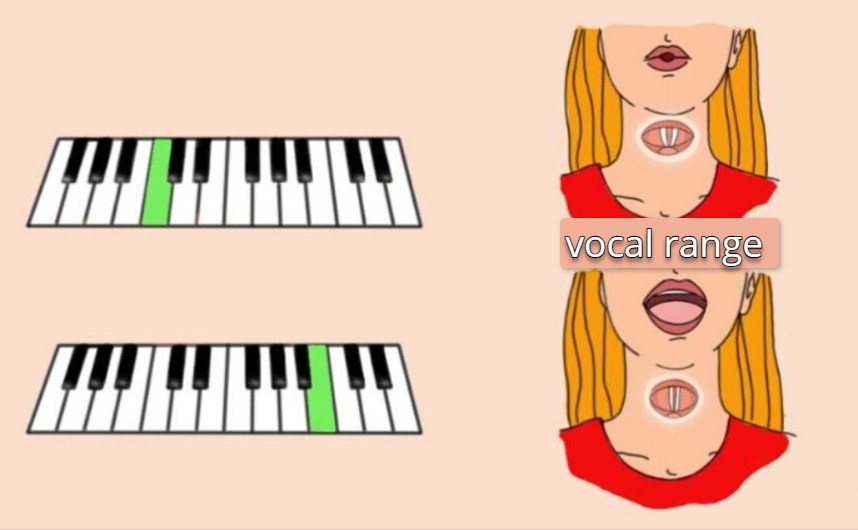As you develop your vocal range, knowing more about your vocal range, style, and other distinctive traits will aid you in your way to becoming more effective as a singer.
Knowing your vocal range will allow you to discover songs for your vocal range. They will highlight your best features, prevent straining and identifying areas to improve. Find out your vocal range and a popular singer matches that can give you some suggestions about how you can use and improve your voice. While you may have had a glimpse of the most common vocal ranges for males as well as females, there’s so more to your vocal which determines its distinct quality and style. In this post, we’ll assist you in identifying your voice range and the other characteristics of your voice so you can become familiar with the instrument you have and develop your voice using this knowledge.
What are the seven names of the vocal range?
Male vocals are divided into 4 different categories:
- Bass – These vocals are distinctive and have a low rumble, resulting in the kind of sound you’d like to hear from subwoofers. True bass vocals aren’t that often heard, but one of the most famous examples can be found in Barry White.
- Baritone is smooth and full of rich baritone vocals carry an adequate amount of “weight they carry while maintaining the ability to reach higher notes, with the right training. Nat King Cole and Tom Jones are two great example of a baritone.
- Tenor is among the top of male voices, tenors are a popular choice in contemporary pop music due to their light tone and the ability to sing beautiful top notes as well as falsettos. Michael Jackson, Stevie Wonder and Luciano Pavarotti are all well-known singers with tenor voices.
- Countertenor – like bass, countertenor’s not very popular among males and is typically heavier and more powerful than the countertenor. Singers such as Vitas may be a good modern example, but due to its roots in choral and classical music, countertenors aren’t nearly as popular in the world of commercial music.
Female vocals are generally classified in three categories:
- Contralto is the female’s lowest voice range. A contralto can be distinctive due to its rich low notes. It is uncommon compared to other ranges of vocal. It’s frequently confused with alto, and it’s crucial to know that alto is used to denote choral parts, and isn’t an individual vocal range. Contraltos with great examples include Annie Lennox and Nina Simone.
- Mezzo-Soprano, which is the most commonly used female vocal range and is distinguished by the capacity to hold lower notes and some stunning high notes. The vocal range is a hit in pop music and has famous examples that include Rihanna, Selena Gomez and Madonna.
- Soprano: light and powerful in the upper register, sopranos are the greatest feminine vocal range. The most well-known models of this category are Bjork, Mariah Carey and FKA Twigs.
So, how do you know your vocal range?
It’s quite simple to complete, particularly when you have an instrument that is able to play a wide variety of notes. A guitar or piano is the best choice, however, even if you don’t have one then it is possible to download a piano app which will perform similarly to perform this exercise. Before doing this, be sure to do some vocal warmups since you’ll be utilizing the entire range of your vocals, which can put strain on your vocal cords. If you’re using a piano keyboard, locate that middle note (also called C4). Try singing vowel sounds like “ah” and then work your way through every note which includes the black keys (or sharps and flats). The first step is to explore your lower range. helps you prepare for the task prior to stretching into the higher range. Check out how low you reach while singing comfortably, and that will determine the lowest note within your range. Perform the same exercise again starting from middle C. However, this time, you will be going up note-by-note. The highest note you can comfortably reach will be the top note you can reach in your range. Make sure you include the falsetto register since it contributes to it. Here’s an approximate range of the most common vocal ranges:
- Bass – E2 to E4
- Baritone – A2 to A4
- Tenor – C3 to C5
- Countertenor – E3 to E5
- Contralto – F3 to F5
- Mezzo-Soprano – A3 to A5
- Soprano – C4 to C6
Of of course, these are simplified approximate vocal spans and it’s possible that your voice is slightly outside of the boundaries. Also, don’t get down if your range isn’t quite as big. While many phenomenal vocalists such as Mariah Carey have an impressive vocal range of just 4 Octaves, having a greater range doesn’t necessarily mean higher quality vocals. It is possible to increase your range but it’s far essential to master the proper manner of voice control and proficiency to make it sound the best you can.
Is this enough to identify your voice’s style? It’s not exactly.
Your vocal type – changes tones and tessitura
Typically, the various vocal ranges overlap. For instance, an alto singer will be able reach some notes that sopranos sing and the list goes on. When your vocal form is influenced by your range of vocals There are additional factors to take into consideration when trying to learn about your voice. Your vocal type, and to a certain extent, your range is determined by tessitura which is the “sweet place’ in your voice, the area the place where you feel most at ease and where your voice showcases its finest qualities. While vocal ranges can overlap but the tessitura of a countertenor, for instance, is greater than that of a tenor.
Our vocal types can also differ depending on the shifts that we experience as we progress across the registers and how the transitions occur within our range. Are you proficient in belting within a specific range, and then, as you progress higher the voice naturally reaches the notes with a falsetto? It’s crucial to be aware of these changes in the register and can use your voice in a way that is effective.
Are you aware that certain singers have a distinct tone, and sound heavier or lighter even though they’re singing identical notes? One way to understand this is to compare the different instruments. Baritone saxophones and alto saxophone may be able to hit the same notes within their range, however their tone will differ. Same goes for vocals. Certain vocalists find it easy to create huge note-like notes that they belt out, while others prefer a gentler approach. We as singers have an individual sound which makes us stand out from other singers and is why it’s crucial to select a repertoire that accentuates our strengths.
In the end, our speaking voice of speech is the one that we feel most at ease with every day. It can aid us in determining the range of our voice since we typically speak within the limits that our tessitura allows.
What do these mean to you?
First, knowing your vocal range will assist you to transpose your singing exercises and songs to fit your vocal range, which will help you avoid excessive strain and harm to your vocal range. It is important to keep in mind that straining our upper range can be more harmful than straining the lower part of our range. When you recognize your sweet voice or tessitura, as being aware of the distinctive tonal characteristics and register changes, you can go another step. Being aware of your voice can help you select a repertoire or create songs that show the best aspects of your voice. It will also make the listener smile. While correct vocal technique and practice are essential for a successful singing career, knowing your voice and how you utilize it will help you shine and sound the best, because you’ll be singing with the manner and tone that is right for your voice perfectly. If you’re not sure about your voice’s range, how you sound or spot any problems which you’d love to address what you should do is to find a vocal coach who will help you overcome any issue. Online tutorials can be helpful however, the person on the screen of an online tutorial hasn’t had the opportunity to hear your voice before, and so they won’t be able discern the vocal characteristics that you have or concentrate on the areas you have trouble with in particular.













